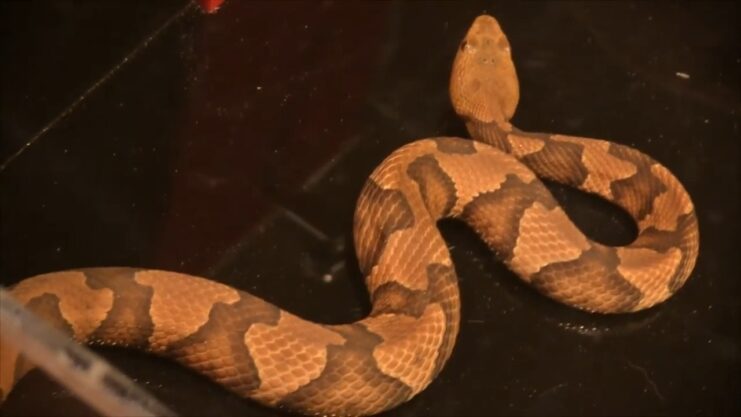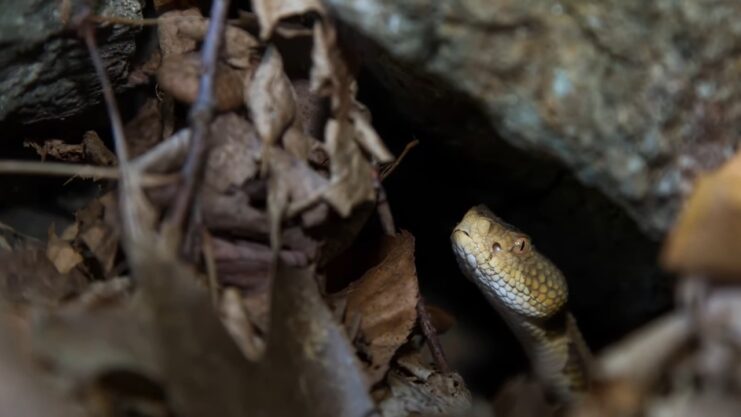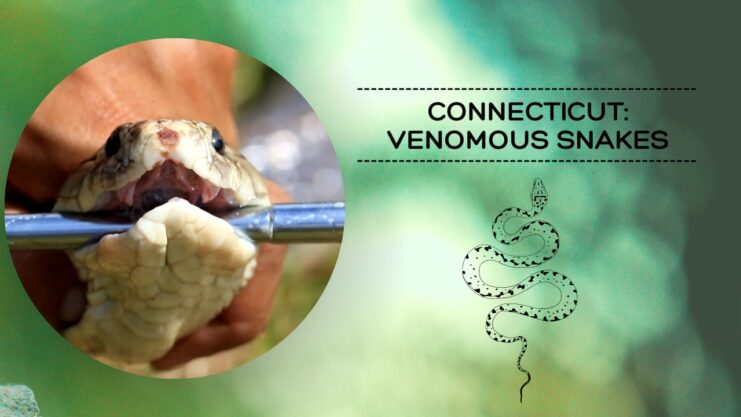Welcome to the wild side of Connecticut! A place where nature’s beauty is intertwined with a hint of danger and a dash of the exotic. This isn’t about the state’s stunning fall foliage or its charming coastal towns. No, we’re diving into the world of Connecticut’s slithering residents—the venomous snakes.
From the coppery Northern Copperhead to the rare Timber Rattlesnake, we’re about to embark on a fascinating journey. So, buckle up, and let’s explore the intriguing world of these creatures together!
The Venomous Duo
1. Northern Copperhead

The Northern Copperhead (Agkistrodon contortrix) is one of the couple venomous snakes found in Connecticut. It is easily recognizable by its light brown body adorned with dark red or brown bands. These snakes are most abundant in the Central Connecticut Lowland ridges and are found near water or on rock ledges.
2. Timber Rattlesnake

The Timber Rattlesnake (Crotalus horridus), on the other hand, is an endangered species in Connecticut. It resides in deciduous forests with rock outcroppings and is known to consume birds and small rodents. This snake is considered the most dangerous venomous snake in the state, primarily found in the western part of Connecticut.
Common Misconceptions
Contrary to popular belief, most snakes in Connecticut are non-venomous. Non-venomous snakes, like the common garter snake, generally have to rely on constriction or a different means to subdue their prey. It’s essential to avoid touching any snake for safety reasons, as even non-venomous snakes can bite when threatened.
While Connecticut has its own unique set of venomous snakes, it’s interesting to note that other states, like Georgia, have a diverse range of venomous snakes that play crucial roles in their respective ecosystems
Another misconception is that venomous snakes are aggressive towards humans. In reality, venomous snakes are typically not aggressive and will only bite humans in self-defense. Venomous snake bites in Connecticut are rare occurrences due to their reclusive nature and avoidance of humans.
The Role of Snakes in the Ecosystem
Snakes, both venomous and non-venomous, play a vital role in maintaining the balance of our ecosystems. They serve as both predators and prey, contributing to the overall health of the environment in several ways. Take a look at the table below to find out in what ways these creatures contribute to the healthy ecosystem:
| Role of Snakes | Description |
|---|---|
| Natural Pest Control | One of the most significant roles snakes play is as natural pest controllers. They feed on a variety of animals, but rodents make up a large portion of many snake species’ diets. By controlling rodent populations, snakes help prevent the spread of diseases that these pests can carry, such as Lyme disease and Hantavirus. |
| Food Source for Other Animals | Snakes are also an important food source for many larger predators, including birds of prey like hawks and eagles, and mammals like foxes and raccoons. Their presence in the food chain helps to maintain the balance of predator and prey populations. |
| Indicators of Ecosystem Health | The presence of snakes in an area can often be an indicator of a healthy ecosystem. Snakes require a stable environment with ample prey and suitable habitats for survival. A decline in snake populations can signal problems in the ecosystem, such as habitat destruction or pollution. |
| Biodiversity | Finally, snakes contribute to biodiversity. Each species of snake has adapted to survive in specific conditions, from deserts to forests, and their presence contributes to the rich tapestry of life on Earth. Protecting snakes helps to preserve the diversity and complexity of our planet’s ecosystems. |
Safety Tips
If you’re planning to explore the great outdoors in Connecticut, here are some safety tips to keep in mind:
1. Be Aware of Your Surroundings
Always be aware of your surroundings. Snakes can blend in with their environment, making them difficult to spot. They may be hiding under leaves, rocks, or logs, so be careful when stepping over or moving these objects.
2. Avoid Nighttime Activities
Snakes are more active at night, so try to avoid outdoor activities during this time. If you must be outside, use a flashlight to illuminate your path and watch where you step.
3. Keep Your Campsite Clean
If you’re camping, keep your campsite clean. Food scraps can attract rodents, which in turn can attract snakes. Store food in sealed containers and dispose of all trash properly.
4. Educate Children
If you’re with children, educate them about the dangers of snakes and instruct them to inform an adult if they spot one. Make sure they understand not to touch or approach any snake they encounter.
5. Know What to Do in Case of a Snakebite
Despite all precautions, snakebites can still occur. It’s important to know what to do in such a situation. Seek immediate medical attention, keep the bitten area lower than the heart if possible, and try to remember the color and shape of the snake to help medical professionals provide the best treatment.
Conclusion
And there you have it, a thrilling journey into the world of Connecticut’s venomous snakes. We’ve debunked myths, shared safety tips, and highlighted the critical role these creatures play in our ecosystem. Remember, these snakes aren’t villains; they’re an integral part of our world, contributing to the balance of nature.
So, the next time you’re out exploring Connecticut’s great outdoors, remember to tread lightly. You’re sharing this beautiful state with some truly remarkable creatures. Stay safe, respect nature, and keep the spirit of adventure alive!




















